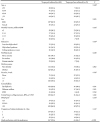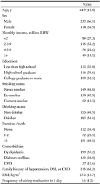Abstract
Background
The prevalence of hypertension reaches 29% in adults over 30 years of age in the Korean population; however, the control rate is merely 44%. The aim of this study was to investigate the associated factors for target blood pressure achievement after triple combination therapy in hypertensive patients.
Methods
From February 2016 to May 2018, 10 family physicians recruited 348 patients, who newly started a triple combination antihypertensive medication. Target blood pressure was defined as a systolic blood pressure (SBP) <140 mmHg and diastolic blood pressure (DBP) <90 mmHg after 6 months of triple combination therapy. Multivariate logistic regression analyses were performed to analyze the associated factors for target blood pressure achievement.
Results
Among the 348 study participants, 317 completed 6 months of treatment. The target achievement rate was 76.3% (242/317). The mean absolute difference and 95% confidence interval (CI) for the SBP and DBP were 10.8 mmHg (8.8 to 12.7) and 6.4 mmHg (5.1 to 7.8), respectively (P<0.05). The odds ratio (OR) for the target blood pressure achievement increased in those with college education or higher (OR, 2.69; 95% CI, 1.22–5.92), those with dyslipidemia (OR, 1.74; 95% CI, 1.01–2.99), and those who were satisfied with the medication (OR, 29.91; 95% CI, 3.70–241.92).
Figures and Tables
Table 2
Changes in blood pressure after Sevikar HCT® (Daiichi Sankyo Europe GmbH, Pfaffenhofen, Germany) treatment

Table 3
Distribution of demographic and lifestyle factors according to achievement of target blood pressure goal

References
1. World Health Organization. Global status report on noncommunicable diseases 2014. Geneva: World Health Organization;2014.
2. Ezzati M, Lopez AD, Rodgers A, Vander Hoom S, Murray CJ. Comparative Risk Assessment Collaborating Group. Selected major risk factors and global and regional burden of disease. Lancet. 2002; 360(9343):1347–1360.


3. Korea Centers for Disease Control and Prevention (KCDC). Korea health statistics 2016: Korea National Health and Nutrition Examination Survey (KNHANES VII-1) [Internet]. Seoul: KCDC;2017. Accessed Mar 20, 2018. Available from: https://knhanes.cdc.go.kr/knhanes/sub04/sub04_03.do?class-Type=7.
4. Petrella RJ, Merikle EP, Jones J. Prevalence, treatment, and control of hypertension in primary care: gaps, trends, and opportunities. J ClinHypertens (Greenwich). 2007; 9(1):28–35.

5. Agyemang C, van Valkengoed I, Koopmans R, Stronks K. Factors associated with hypertension awareness, treatment and control among ethnic groups in Amsterdam, the Netherlands: the SUNSET study. J Hum Hypertens. 2006; 20(11):874–881.


6. Sung YN, Jang SM, Lim DH, Shin SY, Song HJ, Lee SH. Prescribing patterns of antihypertensive drugs by outpatients with hypertension in 2007. Korean J Clin Pharm. 2009; 19(2):167–179.
7. Korean Society Hypertension (KSH). Hypertension Epidemiology Research Working Group. Kim HC, Cho MC. Korea hypertension fact sheet 2018. Clin Hypertens. 2018; 24:13.



8. Dezii CM. A retrospective study of persistence with single-pill combination therapy vs. concurrent two-pill therapy in patients with hypertension. Manag Care. 2009; 9:9 Suppl. 2–6.
9. Bangalore S, Kamalakkan G, Parkar S, Messerli FH. Fixed-dose combinations improve medication compliance: a meta-analysis. Am J Med. 2007; 120(8):713–719.


10. Kato H, Shiraishi T, Ueda S, Kubo E, Shima T, Nagura M, et al. Blood pressure control and satisfaction of hypertensive patients following a switch to combined drugs of an angiotensin receptor blocker and a calcium channel blocker in clinical practice of nephrology. Clin Exp Nephrol. 2015; 19(3):465–473.


11. Chobanian AV, Bakris GL, Black HR, Cushman WC, Green LA, Izzo JL Jr, et al. The seventh report of the Joint National Committee on prevention, detection, evaluation, and treatment of high blood pressure: the JNC 7 report. JAMA. 2003; 289(19):2560–2572.


12. Matsumura K, Arima H, Tominaga M, Ohtsubo T, Sasaguri T, Fujii K, et al. Impact of antihypertensive medication adherence on blood pressure control in hypertension: the COMFORT study. QJM. 2013; 106(10):909–914.


13. Rolnick SJ, Pawloski PA, Hedblom BD, Asche SE, Bruzek RJ. Patient characteristics associated with medication adherence. Clin Med Res. 2013; 11(2):54–65.



14. Daiichi Sankyo, Inc. Tribenzor (olmesartan medoxomil, amlodipine, hydrochlorothiazide) tablets [Internet]. Parsippany: Daiichi Sankyo, Inc;2010. Accessed Jun 1, 2014. Available from: http://www.accessdata.fda.gov/drugsatfda_docs/label/2010/200175s000lbl.pdf.
15. Oparil S, Melino M, Lee J, Fernandez V, Heyrman R. Triple therapy with olmesartan medoxomil, amlodipine besylate, and hydrochlorothizide in adult patients with hypertension: the TRINITY multicenter, randomized, double-blind, 12-week, paralled-group study. Clin Ther. 2010; 32(7):1252–1269.

16. Kereiakes DJ, Chrysant SG, Izzo JL Jr, Littlejohn T 3rd, Melino M, Lee J, et al. Olmesartan/amlodipine/hydrochlorothizide in participants with hypertension and diabetes, chronic kidney disease, or chronic cardiovascular disease: a subanalysis of the multicenter, randomized, double-blind, parallel-group TRINITY study. Cardiovasc Diabetol. 2012; 11:134.



17. de la Sierra A, Barrios V. Blood pressure control with angiotensin receptor blocker-based three-drug combinations. Key trials. Adv Ther. 2012; 29(5):401–415.


18. Novartis Pharmaceuticals Corporation. Exforge HCT (amlodipine, valsartan, hydrochlorothiazide) tablets [Internet]. East Hanover: Novartis Pharmaceuticals Corporation;2009. Accessed Sep 1, 2012. Available from: http://www.accessdata.fda.gov/drugsatfda_docs/label/2009/022314lbl.pdf.
19. Calhoun DA, Lacourcière Y, Chiang YT, Glazer RD. Triple antihypertensive therapy with amlodipine, valsartan, and hydrochlorothiazide: a randomized clinical trial. Hypertension. 2009; 54(1):32–39.

20. Lee DH, Choi YH, Lee KH, Kang DR, Jee SH, Nam CH, et al. Factors associated with hypertension control and antihypertensive medication among hypertensive patients in a community. Korean J Prev Med. 2003; 36(3):289–297.
21. Chang DM, Park IS, Yang JH. Related factors of awareness, treatment, and control of hypertension in Korea: using the fourth Korea National Health & Nutrition Examination Survey. J Digit Converg. 2013; 11(11):509–519.
22. Mazzaglia G, Ambrosioni E, Alacqua M, Filippi A, Sessa E, Immordino V, et al. Adherence to antihypertensive medications and cardiovascular morbidity among newly diagnosed hypertensive patients. Circulation. 2009; 120(16):1598–1605.


24. Webster R, Salam A, de Silva HA, Selak V, Rajapakse S, Amarssekara S, et al. Fixed low-dose triple combination antihypertensive medication vs usual care for blood pressure control in patients with mild to moderate hypertension in Sri Lanka: a randomized clinical trial. JAMA. 2018; 320(6):566–579.






 PDF
PDF ePub
ePub Citation
Citation Print
Print





 XML Download
XML Download